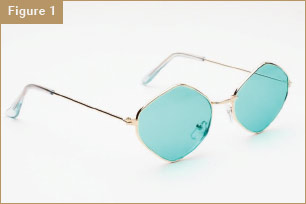Dear Ms. Specs in the City,
I am new at optical dispensing. What advice do you have for a newbie?
Newbie in New York
 Dear Newbie in New York,
Dear Newbie in New York,
Welcome to our fabulous profession! Dispensing eyewear is the perfect combination of right brain/left brain activity: We must think like an engineer and carry on like rock star fashionistas!
The most crucial thing that Ms. Specs wants you to remember is to put lens evaluation first! While the patient/client wants to go directly to the frame display, it is essential that we analyze their prescription first to determine any limitations placed on frame selection by the Rx. It’s bad form to have to say “no” to a patient/client after they have already fallen in love with a drill-mount or nylon cord semi-rimless frame style because you discover after the fact that they have +8.00 Diopters of power in their prescription.
What will the Rx tell us about frame selection limitations and considerations?
Frame eye-sizes are getting larger and larger. We are going back to the 1970s and 1980s, and with this fashion trend, we must take a closer look at optics. For example, large aviator metals, large acetates (plastic), and large and small rimless/facets all require special fitting considerations. Large frame considerations include: thick edges in minus lenses, which can interfere with temple closer or nosepad adjustment. High power minus lenses increase the minification of the eyes and face behind the lens. Plus lenses have thick centers and thin edges and the larger the lens diameter, the thinner the edge. Thin edges can make it impossible to groove and are more fragile for drilling. Cosmetically plus lenses are a poor choice for rimless and semi-rimless frame styles as the bulge of the lens due to center thickness becomes apparent in these frame styles.
When analyzing the spectacle Rx, we know that plus lenses are thickest in the center while minus lenses are thickest at the edge. The thickness increases as the power and lens diameter increase. The thickness can affect cosmetics, lens retention and frame adjustment. In the case of sphero-cylinder, a minus cylinder power is added to the spherical power in a lens at 90 degrees away from the cylinder axis. There is zero cylinder power at the axis. Minus cylinder power will decrease thickness in a plus lens 90 degrees away from its axis or increase the thickness in a minus lens. For example, an Rx of -4.00 -2.00 x 090 will be thicker at 180. The same Rx in a plus lens will be thicker at 90 degrees. If a similar Rx is at an oblique axis (around 045 or 135), consider the total power 90 degrees away if considering an extreme (but fabulous) aviator style. In Fig. 1, where is the thickest parts of the lens in this frame if the Rx is -500 -2.00 x 180? Answer: at the 90 or vertical meridian. Meaning that top and bottom lens edges, because it’s a minus lens, will be thickest.

Yes, we can use a high-index lens material, asphericity and special edging techniques to help, but nothing beats good old-fashioned optical common sense, where frame selection is based on lens Rx evaluation.
My final advice to you, dear Newbie in New York, is always to be gracious and kind when interacting with the patients/clients and guiding them through the frame and lens selection process. Just as you likely feel intimidated as a new optical dispenser, they are exponentially anxious about this very important purchase. A word of caution—don’t be influenced by seasoned co-workers who are impatient or speak badly about the patients/clients. Ms. Specs is on a mission to bring manners back into the dispensary, including optical social media (a conversation for another time). I for one champion the cause for a return to manners. My go-to reference is Judith Martin’s book, Miss Manners’ Guide to Excruciatingly Correct Behavior. Her advice spills over to any situation, personal or professional.
Impeccable manners are always in fashion, and when you add optical knowledge, then you have the winning combination to be a dispensing star!
See Well and Be Well,
Ms. Specs in the City
Laurie Pierce, ABOM













